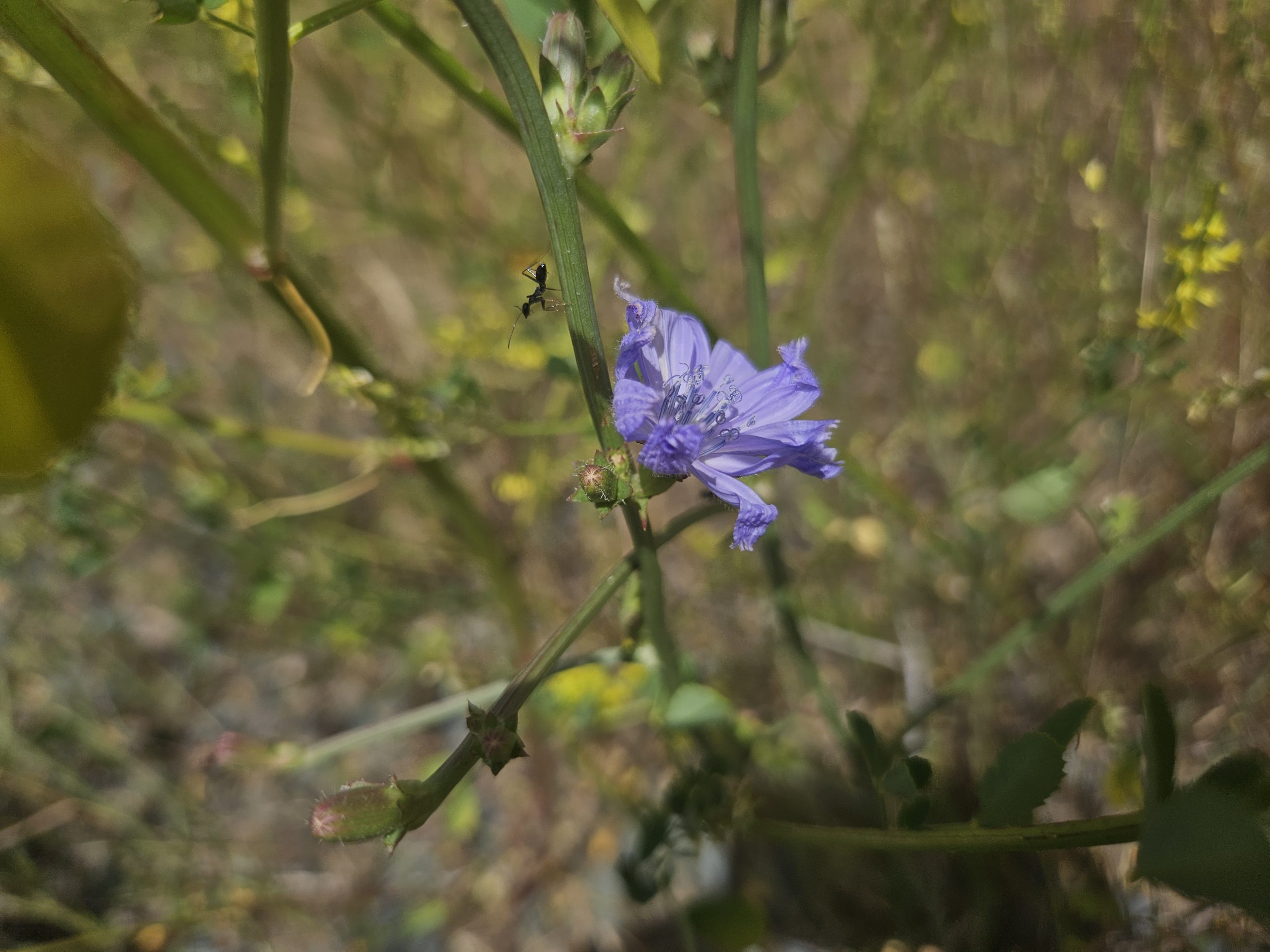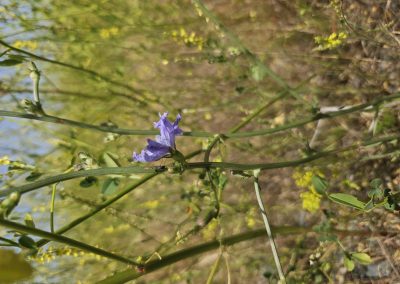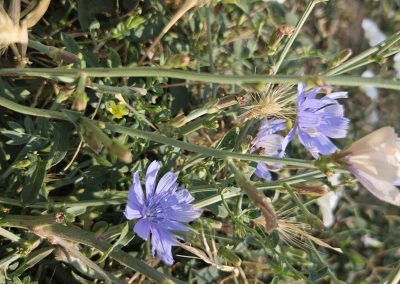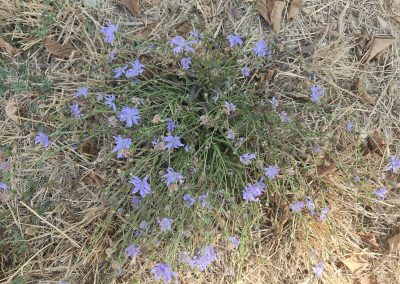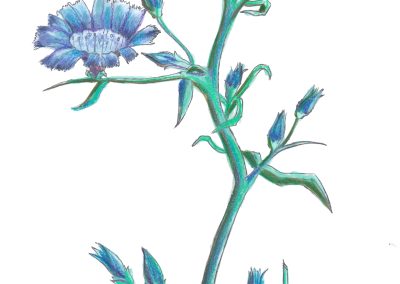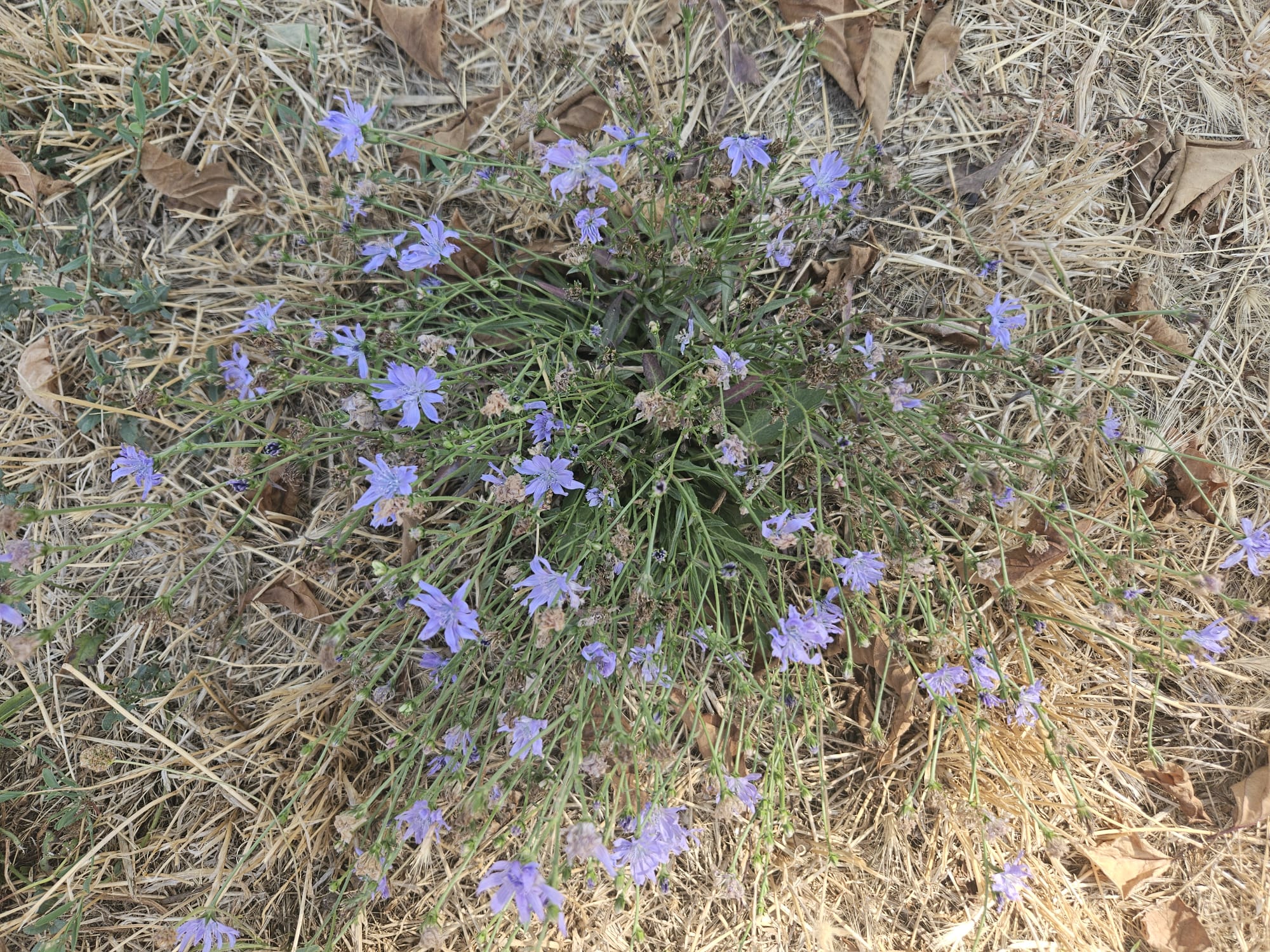Cichorium Intybus
Scientific description
Encrust: Angiospermatophyta (Magnoliophyta)
Class: Dicotyledonatae (Magnoliatae)
Subclass: Asteridae
Order: Asterales
Family: Asteraceae
Subfamily: Cichoroideae (Liguliflorae)
Origin: Europe – northern hemisphere
Description:
Perennial herbaceous species with thick upright roots. The aerial stems are tall, branched, with a rosette of elongated, irregularly notched leaves at the base. Lower stem leaves resemble the basal ones, while upper leaves are entire, sessile, elongated at the tip and cordate at the base. Inflorescences are terminal or axillary calyathids, composed of blue ligulate flowers.
Propagation: By seed, as soon as fruits reach physiological maturity.
Ecology:
In our country it is a common species, thriving in meadows, pastures, uncultivated places, bushes, roadsides, and railways, from the plains to the mountain region. Prefers sunny places with moderate humidity, resistant to drought and frost.
Use:
Both food and medicinal plant. Roasted root used as coffee substitute; some species cultivated for leaves (salads). Roots and aerial part contain inulin, essential amino acids, tannins; recommended in biliary dyskinesia, anorexia, constipation, furunculosis, acne, diabetes. Used also in teas (depurative effect) and as laxative purgative powder. Agriculturally valuable as fodder, an important component of hay.
Încrengătura: Angiospermatophyta (Magnoliophyta)
Clasa: Dicotyledonatae (Magnoliatae)
Subclasa: Asteridae
Ordinul: Asterales
Familia: Asteraceae
Subfamilia: Cichoroideae (Liguliflorae)
Origine: Europa – emisfera nordică
Denumire populară: cicoare
Descrierea:
Specie ierboasă perenă, cu rădăcină verticală groasă. Tulpini aeriene înalte, ramificate, cu rozetă de frunze alungite, neregulat crestate la bază. Frunzele tulpinale inferioare asemănătoare celor bazale; cele superioare întregi, sesile, alungite la vârf și cordate la bază. Inflorescențele de tip calatidiu sunt terminale sau axiale, formate din flori ligulate albastre-azurii.
Înmulțirea: Prin sămânță, imediat ce fructele au ajuns la maturitate fiziologică.
Ecologia:
La noi, specie comună; se dezvoltă prin fânețe, pajiști, locuri necultivate, tufișuri, marginea drumurilor și căilor ferate, de la câmpie până la regiunea montană. Preferă locuri însorite, cu umiditate moderată, rezistă la secetă și ger.
Utilizare:
Plantă alimentară și medicinală. Rădăcina prăjită se folosește ca surogat de cafea; unele specii cultivate pentru frunze (salate). Rădăcinile și partea aeriană conțin inulină, aminoacizi esențiali, taninuri; recomandată în diskinezie biliară, anorexie, constipație, furunculoză, acnee, diabet. Partea aeriană utilizată sub formă de ceaiuri depurative; rădăcina – în pulbere laxativ-purgativă. Importanță agrotehnică: furaj foarte apreciat, component valoros al fânului.
Pericol: Părțile aeriene conțin lactucină, acid cicoric, flavonoide; rădăcina conține inulină.
Γένος: Angiospermatophyta (Magnoliophyta)
Τάξη: Dicotyledonatae (Magnoliatae)
Υποκατηγορία: Asteridae
Τάξη: Asterales
Οικογένεια: Asteraceae
Υποοικογένεια: Cichoroideae (Liguliflorae)
Καταγωγή: Ευρώπη – βόρειο ημισφαίριο
Δημοφιλές όνομα: ραδίκια
Περιγραφή:
Πολυετές βότανο με παχιά όρθια ρίζα. Εναέριοι βλαστοί ψηλοί, διακλαδιζόμενοι, με ροζέτα επιμήκων και ακανόνιστα οδοντωτών φύλλων στη βάση. Κατώτερα φύλλα παρόμοια με τα βασικά· ανώτερα ολόκληρα, άμισχα, επιμήκη στην κορυφή και καρδιόσχημα στη βάση. Ταξιανθίες καλαθιδίου τερματικές ή αξονικές, από γαλάζια άνθη.
Πολλαπλασιασμός: Με σπόρο, μόλις οι καρποί φτάσουν σε φυσιολογική ωριμότητα.
Οικολογία:
Κοινό είδος στη χώρα μας· φυτρώνει σε λιβάδια, βοσκοτόπια, ακαλλιέργητους χώρους, θάμνους, στις άκρες δρόμων και σιδηροδρόμων, από πεδιάδες έως ορεινές περιοχές. Προτιμά ηλιόλουστες θέσεις με μέτρια υγρασία· ανθεκτικό σε ξηρασία και παγετό.
Χρήση:
Τρόφιμο και φαρμακευτικό φυτό. Η καβουρδισμένη ρίζα χρησιμοποιείται ως υποκατάστατο καφέ· μερικά είδη καλλιεργούνται για τα φύλλα (σαλάτες). Ρίζες και υπέργειο τμήμα περιέχουν ινουλίνη, απαραίτητα αμινοξέα, τανίνες· συνιστάται σε δυσκινησία χολής, ανορεξία, δυσκοιλιότητα, φουρουγγουλίτιδα, ακμή, διαβήτη. Υπόγειο μέρος: τσάγια (αποχρεμπτικό), ρίζα: καθαρτική σκόνη. Γεωργική σημασία: υψηλής αξίας ζωοτροφή, σημαντικό συστατικό σανού.
Κίνδυνος: Τα εναέρια μέρη περιέχουν λακτουκίνη, κιχορικό οξύ, φλαβονοειδή· η ρίζα περιέχει ινουλίνη.
Taxon : Angiospermatophyta (Magnoliophyta)
Classe : Dicotyledonatae (Magnoliatae)
Sous-classe : Asteridae
Ordre : Astérales
Famille : Asteraceae
Sous-famille : Cichoroideae (Liguliflorae)
Origine : Europe – hémisphère nord
Description :
Espèce herbacée vivace à racines verticales épaisses. Tiges aériennes hautes, ramifiées, avec une rosette de feuilles allongées et irrégulièrement dentées à la base. Feuilles inférieures semblables aux basales ; supérieures entières, sessiles, allongées à l’extrémité et cordées à la base. Inflorescences calyathides terminales ou axillaires, composées de fleurs ligulées bleu azur.
Multiplication : Par semis, dès que les fruits ont atteint leur maturité physiologique.
Écologie :
Espèce commune dans notre pays ; pousse dans prairies, pâturages, terrains incultes, buissons, bords de routes et voies ferrées, de la plaine à la montagne. Préfère lieux ensoleillés à humidité modérée ; résiste à la sécheresse et au gel.
Utilisation :
Plante alimentaire et médicinale. Racine rôtie utilisée comme substitut du café ; certaines espèces cultivées pour leurs feuilles (salades). Racines et parties aériennes contiennent inuline, acides aminés essentiels, tanins ; recommandées contre dyskinésie biliaire, anorexie, constipation, furonculose, acné, diabète. Partie aérienne aussi en tisanes (effet dépuratif) ; racine en poudre laxative-purgative. Importance agrotechnique : fourrage très apprécié, composant précieux du foin.
Menace : Parties aériennes contiennent lactucine, acide chicorique, flavonoïdes ; racine contient inuline.
Creative writing inspired by Cichorium Intybus
Written by Stici Anisia
The Chicory’s Promise
There once lived a brilliant fairy named Celestia in the lush countryside of France, tucked away among sunflower and wheat fields. She was the envy of everyone who saw her, her eyes the purest summer sky and her hair as golden as the sun. But what really made her stand out was her kind heart and gentle disposition, not just her attractive features.
A charming prince by the name of Julien noticed Celestia as she danced in the field amid the daisies one fateful day. Julien was drawn to Celestia by her elegance and charisma, and he was soon seduced by her unearthly charm. Despite the warnings of his advisors and the disapproval of his family, Julien vowed to make Celestia his bride.
Their love blossomed like the most delicate of flowers, but it was not to last. The king, fearing the repercussions of his son's union with a fairy, issued a decree forbidding their marriage. Heartbroken and desperate, Celestia sought the counsel of the wise elder fairies, who devised a plan to save her from the king's wrath.
Under the cover of night, Celestia was spirited away to the earth, where she would be safe from the king's reach. As dawn broke, she found herself transformed into a humble plant with delicate blue flowers and sturdy green leaves - the chicory plant.
Celestia took comfort in her new form even if her heart ached for her prince. She was determined to endure because she loved them, just as the chicory plant can survive in the most unforgiving environments. And thus, day by day, Celestia's love for Julien continued unwavering, her petals facing the sun in a never-ending dance of devotion.
Chicory flowers, so the legend goes, still hold the imprint of Celestia's eternal love, their petals mirroring the vivid colours of her formerly golden hair. And in the serene French countryside, where the fields extend for miles, the story of Celestia and her prince Julien endures, mumbled among the soft sound of chicory leaves in the breeze.


